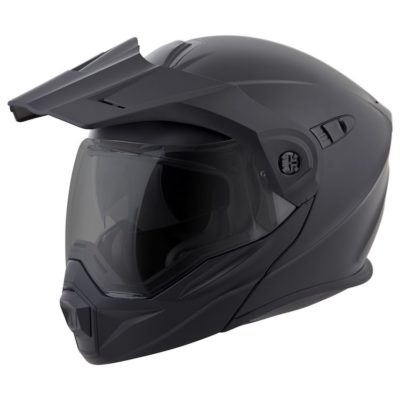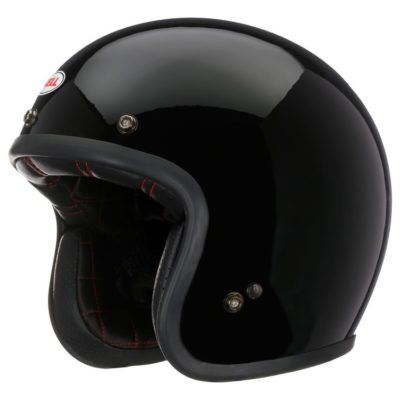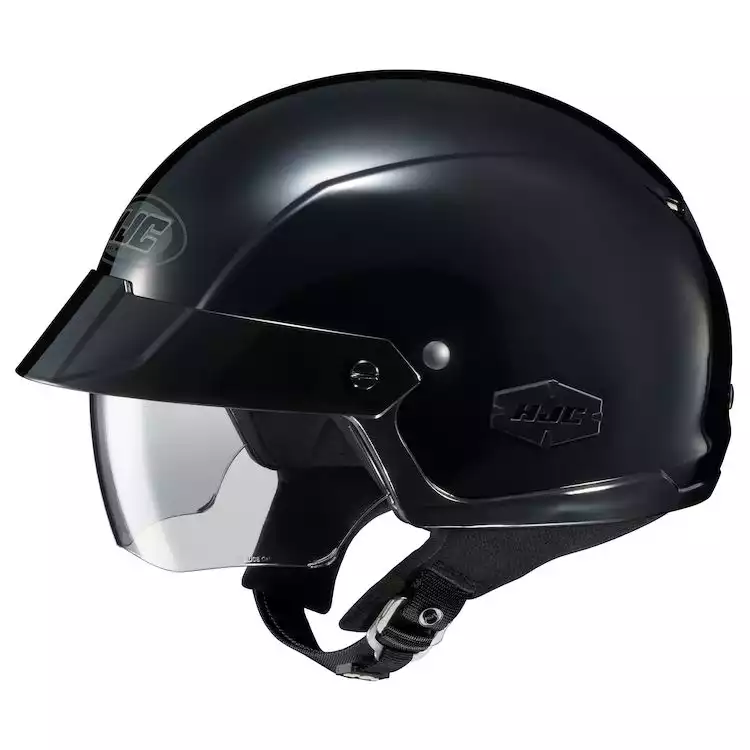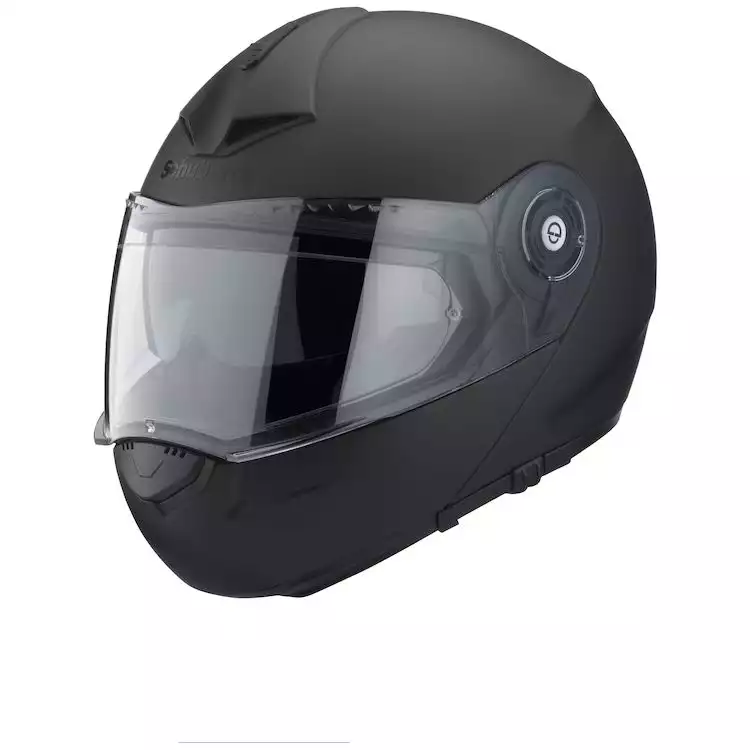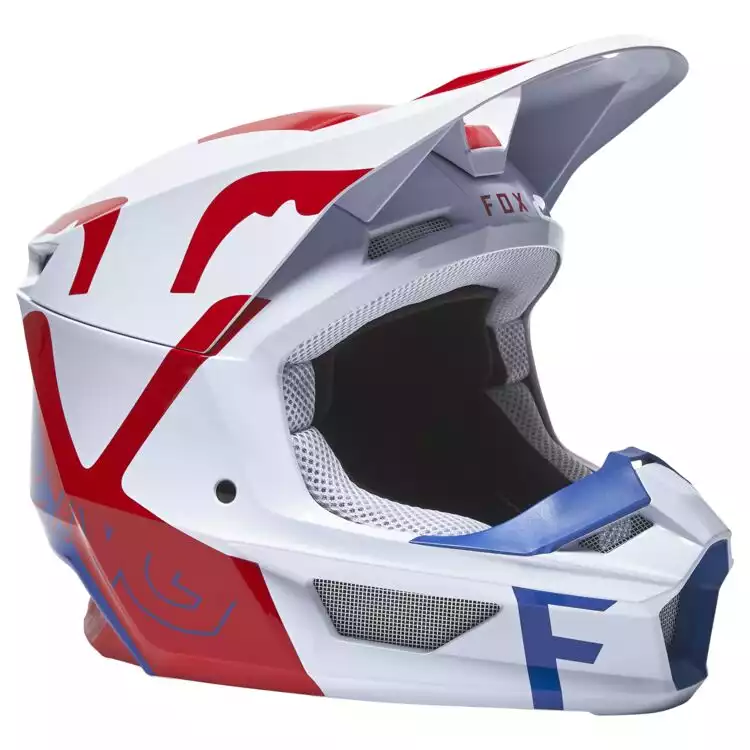A quality, value helmet that’s both safe and comfortable usually costs around $200-$300. Of course, this price can change a lot based on the type of helmet, its extra features, and its level of safety.
Here’s everything I look at to find that sweet spot between cost and quality.
Price Range by Type
There are a number of different motorcycle helmet types, each providing different features and levels of safety.
Because of the different materials and manufacturing processes involved, different types of helmet fall into very different price ranges.
Let’s have a look at the average costs of the more popular options.
Full Face
Full-face helmets provide protection not just for the top of your head, but your face and chin as well. A full chin guard wraps around the front of your face below a transparent face shield.
This makes them the most protective and arguably the most popular helmet type these days, especially with regular commuters and sports bike riders.
Because of their popularity, there are a lot of models at a wide range of prices. In general, they require more material since they cover your whole head, and they’re more manufacturing-intensive, especially since they have to include things like ventilation for comfort.
There are cheap models, sometimes below $150, and luxury models that go over $1,500.
I’d recommend spending around $250 – $300 for a good intersection of quality and value. That said, any full-face helmet from a renowned manufacturer in the $200-$900 range will be safe and reliable.
Price Range: $200-$1,500
Recommended Lid: Icon Airflite
Open Face
Open face helmets come down over the sides of your head, but they don’t wrap around your chin. This allows air to pass over your face making them more comfortable but much less protective.
Open face helmets have much simpler designs with less material involved. As a result, they’re less expensive than open face helmets, with the most top-shelf models rarely going over $600.
You may even find basic, cheap models under $50. I suggest spending around $150.
Read our roundup of the best three quarter motorcycle helmets.
Price Range: $50-$600
Recommended Lid: Bell Custom 500
Half Face
A half-face helmet has even less material and fewer features than an open-face helmet. Basically, it’s a bowl that just protects the very top of your head.
Since there’s not a lot to them, half-face helmets rarely cost over $100. There are a number of good models for about $80 that are stylish and well made.
Price Range: $40-$100
Recommended Lid: HJC IS-Cruiser
Modular/Flip-Up
Modular helmets are complex lids that can be changed between both full face and open face setups. There’s a chin guard that wraps around the front of your face, but this can be flipped up—or in some cases removed—to open your face to the wind.
Even though modular helmets have more complicated designs, they’re not necessarily more expensive than full-face helmets. That’s probably because companies haven’t developed as many models yet, and there’s a lot less demand.
There are even some cheap modular helmets under $100 while the more expensive models are around $900.
If you’re buying a modular helmet, you clearly value technological innovation and versatility, so I’d recommend sticking to the higher end of this range to make sure you’re getting a modular helmet that’s going to work smoothly time after time. Spend about $600 or more.
Read our guide to the top modular helmets.
Price Range: $100-$900
Recommended Lid: Schuberth C3 Pro
Motocross/Off-Road
Motocross helmets have extra safety features due to the dangerous nature of the sport. These include extended visors and chin guards as well as wider ranges of vision.
They usually don’t have eye shields, though, and aren’t great for other types of motorcycle riding.
Motocross helmets range anywhere from $50 to $900. If you’re riding off-road, take safety seriously and don’t skimp.
On the other hand, you don’t have to spend all your money on a brand name or cool decals if you don’t want to. I find that $300 is a good sweet spot.
Price Range: $50-$900
Recommended Lid: Fox Racing V1 Skew
Dual Sport
Dual sport helmets are basically motocross helmets that also work for other types of motorcycle riding: commuting, touring, whatever.
There are fewer models, so they have a narrower price range of about $100-$800. There are a number of quality models right around $200.
Price Range: $100-$800
Recommended Lid: Scorpion EXO-AT950
Cheap vs Expensive—Trade Offs
As with most things in life, when it comes to motorcycle helmets, you get what you pay for. Getting a cheaper versus a more expensive helmet will certainly come with its trade-offs.
The biggest trade-off is the quality of construction. Generally speaking, a cheaper helmet will still be safe, at least if it meets certain standards (more on this later), but other features most likely won’t hold up as well.
For example, chin straps may start to fray sooner on cheaper helmets, and rotating pieces like those on the face shield may stop working correctly.
Similarly, features like ventilation and sweat-wicking might not work as well because the company skimped in the manufacturing process.
In fact, really cheap models may not even have certain features at all. You may save a few bucks, but a lack of ventilation will be miserable in the summer.
A small discount in price could ultimately mean sacrificing your hearing if there’s no noise cancellation.
Another big trade-off is style. Cheaper brands and models don’t put a lot of work into their designs, so the coolest-looking helmets tend to be more expensive.
For some, this doesn’t matter, but if you want to be the most stylish rider on the street, you’ll have to pay a little more.
Safety Standards
Most helmets you find on the market will meet some kind of safety standard, but certain standards are stricter than others.
Making helmets safer requires more quality manufacturing, and that drives up the price.
Here are the relevant safety standards and how they might affect price:
Department of Transportation (DOT)
This is a certification given by the US Department of Transportation to helmets that meet their testing requirements. The vast majority of helmets sold in the US will meet this standard because it’s actually required by law in a lot of places.
This is considered the most basic standard available on even inexpensive helmets. Helmets that meet this standard will have a DOT sticker on them.
Economic Commission for Europe (ECE)
This standard is essentially the equivalent of the DOT sticker for the European Union. If you live in the EU, most helmets will meet this standard. Some companies who sell their helmets in both the US and Europe may test for both standards.
Snell Memorial Foundation (SNELL M2020)
This standard is rarely required by law except for some racing applications. Instead, some name-brand helmet companies put their helmets through this standard’s testing process because it’s much more rigorous. The helmet must be high quality and very safe. As a result, a SNELL-rated helmet is probably more expensive.
Related: Safest motorcycle helmets available now
What Factors Affect Helmet Price?
Weight
No one wants a heavy helmet. It’s uncomfortable on your head and wears on your neck muscles over time. Unfortunately, as a general rule, the lighter the helmet, the more you’ll have to pay.
That’s because weight depends on the material used. Carbon fiber is a strong yet lightweight material used in the most expensive helmet models, while fiberglass is a much cheaper option that weighs more.
Helmets often use a composite or mixture of the two with a higher percentage of carbon fiber meaning a higher price.
Noise Cancellation
Noise cancellation in a helmet is usually achieved by making it a tighter fit around the neck so that wind doesn’t enter. It may also have snug cushioning around the ears that drowns out engine noise.
Noise cancellation takes extra detail in the manufacturing process, so helmets with better noise cancellation are usually more expensive. Also see how to make my helmet quieter.
Ventilation
Just take a whiff of my helmet’s inner lining after a couple of days, and you’ll understand just how hot it can get inside a full-face helmet during the summer.
These days, most full-face helmets have some type of ventilation to help with this, but the quality varies considerably between models.
Really well-ventilated helmets suck air in the front of the helmet and let it pass out the back through exhaust vents. Sometimes, they can even achieve cooler temperatures inside your helmet than outside.
Of course, these effective systems often cost a lot more while you can get lower-quality ventilation for less.
Comfort
Top-shelf helmets are more likely to be comfortable because the manufacturing process is more detailed. In fact, some expensive models are even handcrafted. This means they have a more nuanced shape that conforms to your head.
That said, don’t just assume the most expensive model is the most comfortable for you. Everyone has a different head shape, and many brands and vendors specify the shapes of their different models.
Getting the appropriate helmet for your head will be the biggest factor in comfort.
Similarly, the quality of the helmet’s inner lining also contributes to price. A softer or more adjustable inner lining will be more comfortable but also more expensive.
Brand
There seem to be two types of people: those who are so loyal to a brand that they’ll pay any price if its name is on a product and those who claim brands don’t matter and always simply buy the cheapest model. I’ve learned that neither of these groups is right.
Famous name helmet brands are often more expensive, but a lot of the time, you really are getting higher quality. More importantly, the history of the brand can give you confidence in its reliability as well as the company’s customer service.
On the other hand, newer brands on the market may be just as good. However, because they’re less well known, they can’t demand as high a price. These new, less-expensive brands are a great opportunity for good value.
The Sweet Spot
Once you know what you want in a helmet and how these things affect the price, you can find “the sweet spot.” This is what I like to call the perfect intersection between quality and cost. At this price, you’ll get a safe helmet with all the features you need without going over budget.
